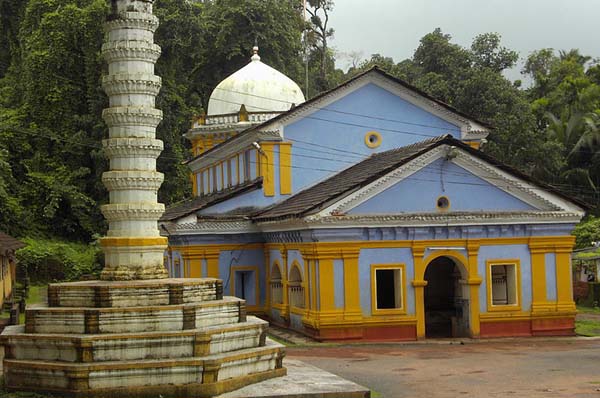Shri Saptakoteshwar Temple

Information of Shri Saptakoteshwar Temple, Narve, Goa
The Shri Saptakoteshwar Temple is located in Narve in the Indian territory of Goa. The temple is dedicated to the Hindu deity Lord Shiva who is believed to be the Supreme Being. Narve is a village situated about 35 kilometres from the Panaji, the capital of Goa. It can be reached by means of a ferryboat only. Among the numerous Shiva temple located in Goa the Saptakoteshwar Temple stands as one of the sixth great temples.
Shri Saptakoteshwar Temple Religious Significance
The name Saptakoteshwar refers as Sapt meaning seven and Koteshwar meaning lord of crores. The most important festival celebrated in the Temple is Gokulashtami, referred to as a day when Lord Shiva incarnated to gives boons to the seven sages.
Like any other Hindu Temple dedicated to Lord Shiva, Shiva Raatri is another festival celebrated in the temple. A large number of Devotees flock in from around the Konkan area. His Devotees keep awake throughout the night singing his glories and offering him immense prayers and prasadam. Lord Shiva overjoyed with his devotee's dedication bestows blessings and boons. People also take a dip in the sacred tank named as Panchaganga Tirtha with a belief that all their sins and illness will be removed. The name Panchaganga Tirtha signifies the meeting point of five holy rivers.
Shri Saptakoteshwar Temple Mythology
The temple has an interesting myth of seven holy sages. These seven sages set out to pray to Lord Shiva in the location of the temple where five holy rivers met. They continued their prayers for seven crore years when finally Lord Shiva granted their wish and agreed to reside in the holy spot in his Saptakoteshwar form.
Shri Saptakoteshwar Temple History
The Shri Saptakoteshwar Temple was built as a family temple of the Kadamba dynasty around twelfth century. The Kings of the Kadamba dynasty were greatly devotees of Lord Shiva. Kamaldevi wife of one of the Kings of the Kadamba dynasty was an ardent devotee of Lord Shiva so he built the temple for her.
The Shri Saptakoteshwar Temple faced many invasions and restorations losing its original glory and grandeur.
After the defeat of the Kadamba dynasty in 1352, by the Bahmani Sultan Allauddin Hasan Gangu, they demolished the Saptakosteshwar temple and many other Hindu temples during their rule for fourteen years.
The Bahmani Sultan army were defeated in 1367 by Vijaynagar army lead by King Harihararaya who reconstructed the lost temple of Saptakoteshwar.
The final invasion was by the Portuguese army in 1560. They destroyed the temple and built a chapel in the name of Nossa Senhora De Candelaria. The linga that was installed in the temple was used as a well shaft but was later rescued by Hindus and was reinstalled in another temple in Bicholim.
Shri Saptakoteshwar Temple Architectural Significance
The Shri Saptakoteswar temple was built with a blend of Mughal and European style architecture. It has a Mughal styled white dome on an octagonal platform with slanting roofs. Other parts of the temple are in European style such as the prayer hall and a lamp tower in front of the temple which is known as the Deepastamba. The Deepastamba is the most eye catching structure of the temple which enhances the importance and the spirituality from the core. Thus if you are here, it's not just the holiness of the temples, but the eye catching architectural style are worth to relish and soak in the beauty that glorify the architectural phenomenon of the era.
Many gold coins were found belonging to different dynasties with inscription saying, "with the grace of Saptakoteshwar", in Sanskrit. The main temple is surrounded a number of other smaller temples of Brahminical laterite and stone caves. The wall of the temple is carved with niches. There are a number of structures surrounding the main shrine such as the shrine of Kalbhairav with padukas or feet of Dattatraya is carved out of stone. There are pillars in the premises of the temple. Another noteworthy feature is a man made tunnel and also the Panchaganga Tirtha a scared tank used to devotees to take a dip and remove all sins. Altogether the temple is built with resemblance to many other Hindu Temples.
- Andhra Pradesh Temples
- Assam Temples
- Bihar Temples
- New Delhi Temples
- Goa Temples
- Gujarat Temples
- Jammu and Kashmir Temples
- Karnataka Temples
- Kerala Temples
- Madhya Pradesh Temples
- Maharashtra Temples
- Odisha Temples
- Punjab Temples
- Rajasthan Temples
- Sikkim Temples
- Tamil Nadu Temples
- Telangana Temples
- Uttar Pradesh Temples
- Uttarakhand Temples
- West Bengal Temples